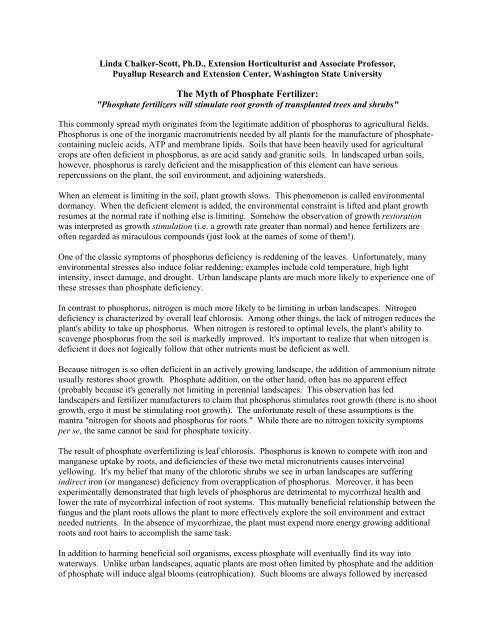The Myth of Phosphate Fertilizer: - Puyallup Research & Extension ...
The Myth of Phosphate Fertilizer: - Puyallup Research & Extension ...
The Myth of Phosphate Fertilizer: - Puyallup Research & Extension ...
Create successful ePaper yourself
Turn your PDF publications into a flip-book with our unique Google optimized e-Paper software.
Linda Chalker-Scott, Ph.D., <strong>Extension</strong> Horticulturist and Associate Pr<strong>of</strong>essor,<br />
<strong>Puyallup</strong> <strong>Research</strong> and <strong>Extension</strong> Center, Washington State University<br />
<strong>The</strong> <strong>Myth</strong> <strong>of</strong> <strong>Phosphate</strong> <strong>Fertilizer</strong>:<br />
"<strong>Phosphate</strong> fertilizers will stimulate root growth <strong>of</strong> transplanted trees and shrubs"<br />
This commonly spread myth originates from the legitimate addition <strong>of</strong> phosphorus to agricultural fields.<br />
Phosphorus is one <strong>of</strong> the inorganic macronutrients needed by all plants for the manufacture <strong>of</strong> phosphatecontaining<br />
nucleic acids, ATP and membrane lipids. Soils that have been heavily used for agricultural<br />
crops are <strong>of</strong>ten deficient in phosphorus, as are acid sandy and granitic soils. In landscaped urban soils,<br />
however, phosphorus is rarely deficient and the misapplication <strong>of</strong> this element can have serious<br />
repercussions on the plant, the soil environment, and adjoining watersheds.<br />
When an element is limiting in the soil, plant growth slows. This phenomenon is called environmental<br />
dormancy. When the deficient element is added, the environmental constraint is lifted and plant growth<br />
resumes at the normal rate if nothing else is limiting. Somehow the observation <strong>of</strong> growth restoration<br />
was interpreted as growth stimulation (i.e. a growth rate greater than normal) and hence fertilizers are<br />
<strong>of</strong>ten regarded as miraculous compounds (just look at the names <strong>of</strong> some <strong>of</strong> them!).<br />
One <strong>of</strong> the classic symptoms <strong>of</strong> phosphorus deficiency is reddening <strong>of</strong> the leaves. Unfortunately, many<br />
environmental stresses also induce foliar reddening; examples include cold temperature, high light<br />
intensity, insect damage, and drought. Urban landscape plants are much more likely to experience one <strong>of</strong><br />
these stresses than phosphate deficiency.<br />
In contrast to phosphorus, nitrogen is much more likely to be limiting in urban landscapes. Nitrogen<br />
deficiency is characterized by overall leaf chlorosis. Among other things, the lack <strong>of</strong> nitrogen reduces the<br />
plant's ability to take up phosphorus. When nitrogen is restored to optimal levels, the plant's ability to<br />
scavenge phosphorus from the soil is markedly improved. It's important to realize that when nitrogen is<br />
deficient it does not logically follow that other nutrients must be deficient as well.<br />
Because nitrogen is so <strong>of</strong>ten deficient in an actively growing landscape, the addition <strong>of</strong> ammonium nitrate<br />
usually restores shoot growth. <strong>Phosphate</strong> addition, on the other hand, <strong>of</strong>ten has no apparent effect<br />
(probably because it's generally not limiting in perennial landscapes. This observation has led<br />
landscapers and fertilizer manufacturers to claim that phosphorus stimulates root growth (there is no shoot<br />
growth, ergo it must be stimulating root growth). <strong>The</strong> unfortunate result <strong>of</strong> these assumptions is the<br />
mantra "nitrogen for shoots and phosphorus for roots." While there are no nitrogen toxicity symptoms<br />
per se, the same cannot be said for phosphate toxicity.<br />
<strong>The</strong> result <strong>of</strong> phosphate overfertilizing is leaf chlorosis. Phosphorus is known to compete with iron and<br />
manganese uptake by roots, and deficiencies <strong>of</strong> these two metal micronutrients causes interveinal<br />
yellowing. It's my belief that many <strong>of</strong> the chlorotic shrubs we see in urban landscapes are suffering<br />
indirect iron (or manganese) deficiency from overapplication <strong>of</strong> phosphorus. Moreover, it has been<br />
experimentally demonstrated that high levels <strong>of</strong> phosphorus are detrimental to mycorrhizal health and<br />
lower the rate <strong>of</strong> mycorrhizal infection <strong>of</strong> root systems. This mutually beneficial relationship between the<br />
fungus and the plant roots allows the plant to more effectively explore the soil environment and extract<br />
needed nutrients. In the absence <strong>of</strong> mycorrhizae, the plant must expend more energy growing additional<br />
roots and root hairs to accomplish the same task.<br />
In addition to harming beneficial soil organisms, excess phosphate will eventually find its way into<br />
waterways. Unlike urban landscapes, aquatic plants are most <strong>of</strong>ten limited by phosphate and the addition<br />
<strong>of</strong> phosphate will induce algal blooms (eutrophication). Such blooms are always followed by increased
acterial activity, resulting in lowered oxygen levels and the eventual death <strong>of</strong> fish and other animals. As<br />
green industry pr<strong>of</strong>essionals, it is incumbent upon us to recognize that excessive use <strong>of</strong> phosphorus in<br />
landscapes is a resource-wasteful, ecosystem-damaging practice.<br />
Bottom line:<br />
• Maintain organic material (mulch) on landscapes; this provides a slow release <strong>of</strong> phosphorus and<br />
other needed macro- and micronutrients over time.<br />
• Don't use phosphate fertilizer when transplanting; in most cases ammonium nitrate fertilizer is<br />
adequate.<br />
• If you have a nutrient deficiency that is not relieved by nitrogen addition, try a foliar application <strong>of</strong><br />
likely nutrients and see if the symptoms are alleviated. This prevents excessive addition <strong>of</strong><br />
mineral nutrients to the soil.<br />
For more information, please visit Dr. Chalker-Scott’s web page at http://www.theinformedgardener.com.
















